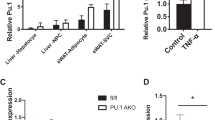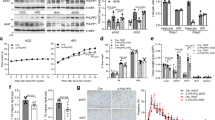Abstract
We have recently reported that PPARα deficiency leads to hypoglycaemia and hypoinsulinemia in mice (Yessoufou et al. Endocrinology 147:4410–4418, 2006). Besides, these mice exhibited high adiposity with an inflammatory state. We, therefore, assessed, in this study, the effects of PPARα deficiency on the expression of mRNA encoding for the insulin gene transcription factors in pancreatic β-cells along with those implicated in inflammation in adipose tissues. On fasting, the adult PPARα-null mice were hypoglycemic. Serum insulin concentrations and its pancreatic mRNA transcripts were downregulated in PPARα-null mice, suggesting that PPARα gene deletion contributes to low insulin gene transcription. The PPARα gene deletion downregulates the mRNA expression of insulin gene transcription factors, i.e., Pdx-1, Nkx6.1, and MafA. Besides, the pancreatic function was diminished by PPARα deficiency as PPARα-null mice expressed low pancreatic Glut2 and glucokinase mRNA. PPARα-null mice also expressed high adiponectin and leptin mRNA levels compared to wild type animals. Adipose tissues of PPARα-null mice exhibited upregulation of CD14 and CD68 mRNA, generally expressed by macrophages. PPARα gene deletion downregulates the adipocyte mRNA of certain pro-inflammatory agents, like MCP-1, TNF-α, IL-1β, IL-6, and RANTES, though pro-inflammatory TLR-2 and TLR-4 mRNAs were upregulated in the adipose tissues. Our results suggest that PPARα deficiency, in mice, is implicated in the modulation of insulin gene transcription and inflammatory status in adipose tissues.









Similar content being viewed by others
Abbreviations
- GK:
-
Glucokinase
- Nkx6.1:
-
NK6 transcription factor related-locus-1
- Pdx-1:
-
Pancreatic and duodenal homeobox-1
- PPARα:
-
Peroxisome proliferator-activated receptor-α
- MCP-1:
-
Monocyte-chemoattractant protein-1
- RANTES:
-
Regulated on activation of normal T cell expressed and secreted
- SREBP1c:
-
Sterol response element-binding protein 1c
- TG:
-
Triglyceride
- TLR:
-
Toll-like receptor
- FFA:
-
Free fatty acids
- WAT:
-
White adipose tissue
- PBS:
-
Phosphate buffered saline
- WT:
-
Wild type
References
Issemann I, Green S (1990) Activation of a member of the steroid hormone receptor superfamily by peroxisome proliferators. Nature 347:645–650. doi:10.1038/347645a0
Wahli W (2002) Peroxisome proliferator-activated receptors (PPARs): from metabolic control to epidermal wound healing. Swiss Med Wkly 132:83–91
Braissant O, Foufelle F, Scotto C et al (1996) Differential expression of peroxisome proliferator-activated receptors (PPARs): tissue distribution of PPAR-alpha, -beta, and -gamma in the adult rat. Endocrinology 137:354–366. doi:10.1210/en.137.1.354
Zambon A, Gervois P, Pauletto P et al (2006) Modulation of hepatic inflammatory risk markers of cardiovascular diseases by PPAR-{alpha} activators: clinical and experimental evidence. Arterioscler Thromb Vasc Biol 26:977–986. doi:10.1161/01.ATV.0000204327.96431.9a
Yessoufou A, Hichami A, Besnard P et al (2006) PPARα deficiency increases the risk of maternal abortion and neonatal mortality in murine pregnancy with or without diabetes mellitus: modulation of T cell differentiation. Endocrinology 147:4410–4418. doi:10.1210/en.2006-0067
Guerre-Millo M, Rouault C, Poulain P et al (2001) PPAR-alpha-null mice are protected from high-fat diet-induced insulin resistance. Diabetes 50:2809–2814. doi:10.2337/diabetes.50.12.2809
Guillausseau PJ (2003) Pathogenesis of type 2 diabetes mellitus. Rev Med Interne 24:730–737. doi:10.1016/S0248-8663(03)00244-3
German K, Bedwani J, Davies J et al (1994) An assessment of the contribution of visco-elastic factors in the aetiology of poor compliance in the human neuropathic bladder. Br J Urol 74:744–748
Wicksteed B, Alarcon C, Briaud I et al (2003) Glucose-induced translational control of proinsulin biosynthesis is proportional to preproinsulin mRNA levels in islet beta-cells but not regulated via a positive feedback of secreted insulin. J Biol Chem 278:42080–42090. doi:10.1074/jbc.M303509200
Tillmar L, Carlsson C, Welsh N (2002) Control of insulin mRNA stability in rat pancreatic islets. Regulatory role of a 3′-untranslated region pyrimidine-rich sequence. J Biol Chem 277:1099–1106. doi:10.1074/jbc.M108340200
Johnson JD, Ahmed NT, Luciani DS et al (2003) Increased islet apoptosis in PDX1 +/− mice. J Clin Invest 111:1147–1160
Sander M, Sussel L, Conners J et al (2000) Homeobox gene Nkx6.1 lies downstream of Nkx2.2 in the major pathway of beta-cell formation in the pancreas. Development 127:5533–5540
Schisler JC, Jensen PB, Taylor DG et al (2005) The Nkx6.1 homeodomain transcription factor suppresses glucagon expression and regulates glucose-stimulated insulin secretion in islet beta cells. Proc Natl Acad Sci USA 102:7297–7302. doi:10.1073/pnas.0502168102
Docherty HM, Hay CW, Ferguson LA et al (2005) Relative contribution of PDX-1, MafA and E47/beta2 to the regulation of the human insulin promoter. Biochem J 389:813–820. doi:10.1042/BJ20041891
Waki H, Tontonoz P (2007) Endocrine functions of adipose tissue. Annu Rev Pathol 2:31–56. doi:10.1146/annurev.pathol.2.010506.091859
Weisberg SP, McCann D, Desai M et al (2003) Obesity is associated with macrophage accumulation in adipose tissue. J Clin Invest 112:1796–1808
Triantafilou M, Triantafilou K (2002) Lipopolysaccharide recognition: CD14, TLRs and the LPS-activation cluster. Trends Immunol 23:301–304. doi:10.1016/S1471-4906(02)02233-0
Wu H, Ghosh S, Perrard XD et al (2007) T-cell accumulation and regulated on activation, normal T cell expressed and secreted upregulation in adipose tissue in obesity. Circulation 115:1029–1038. doi:10.1161/CIRCULATIONAHA.106.638379
Lee SS, Pineau T, Drago J et al (1995) Targeted disruption of the alpha isoform of the peroxisome proliferator-activated receptor gene in mice results in abolishment of the pleiotropic effects of peroxisome proliferators. Mol Cell Biol 15:3012–3022
Bihan H, Rouault C, Reach G et al (2005) Pancreatic islet response to hyperglycemia is dependent on peroxisome proliferator-activated receptor alpha (PPARalpha). FEBS Lett 579:2284–2288. doi:10.1016/j.febslet.2005.03.020
Folch J, Lees M, Stanley Sloane GH (1957) A simple method for the isolation and purification of total lipids from animal tissues. J Biol Chem 226:497–509
Slover HT, Lanza E (1979) Quantitative analysis of food fatty acids by capillary gas chromatography. J Am Oil Chem Soc 56:933–943. doi:10.1007/BF02674138
Xu H, Barnes GT, Yang Q et al (2003) Chronic inflammation in fat plays a crucial role in the development of obesity-related insulin resistance. J Clin Invest 112:1821–1830
Yoshikawa H, Tajiri Y, Sako Y et al (2001) Effects of free fatty acids on beta-cell functions: a possible involvement of peroxisome proliferator-activated receptors alpha or pancreatic/duodenal homeobox. Metabolism 50:613–618. doi:10.1053/meta.2001.22565
Kroetz DL, Yook P, Costet P et al (1998) Peroxisome proliferator-activated receptor alpha controls the hepatic CYP4A induction adaptive response to starvation and diabetes. J Biol Chem 273:31581–31589. doi:10.1074/jbc.273.47.31581
Kersten S, Seydoux J, Peters JM et al (1999) Peroxisome proliferator-activated receptor alpha mediates the adaptive response to fasting. J Clin Invest 103:1489–1498. doi:10.1172/JCI6223
Leibiger B, Moede T, Uhles S et al (2002) Short-term regulation of insulin gene transcription. Biochem Soc Trans 30:312–317. doi:10.1042/BST0300312
Lawrence MC, McGlynn K, Park BH et al (2005) ERK1/2-dependent activation of transcription factors required for acute and chronic effects of glucose on the insulin gene promoter. J Biol Chem 280:26751–26759. doi:10.1074/jbc.M503158200
Ahlgren U, Jonsson J, Jonsson L et al (1998) Beta-cell-specific inactivation of the mouse Ipf1/PDX1 gene results in loss of the beta-cell phenotype and maturity onset diabetes. Genes Dev 12:1763–1768. doi:10.1101/gad.12.12.1763
Peters JM, Hennuyer N, Staels B et al (1997) Alterations in lipoprotein metabolism in peroxisome proliferator-activated receptor alpha-deficient mice. J Biol Chem 272:27307–27312. doi:10.1074/jbc.272.43.27307
Costet P, Legendre C, More J et al (1998) Peroxisome proliferator-activated receptor alpha-isoform deficiency leads to progressive dyslipidemia with sexually dimorphic obesity and steatosis. J Biol Chem 273:29577–29585. doi:10.1074/jbc.273.45.29577
Campbell FM, Kozak R, Wagner A et al (2002) A role for peroxisome proliferator-activated receptor alpha (PPARalpha) in the control of cardiac malonyl-CoA levels: reduced fatty acid oxidation rates and increased glucose oxidation rates in the hearts of mice lacking PPARalpha are associated with higher concentrations of malonyl-CoA and reduced expression of malonyl-CoA decarboxylase. J Biol Chem 277:4098–4103. doi:10.1074/jbc.M106054200
Park CW, Kim HW, Ko SH et al (2006) Accelerated diabetic nephropathy in mice lacking the peroxisome proliferator-activated receptor alpha. Diabetes 55:885–893. doi:10.2337/diabetes.55.04.06.db05-1329
Djouadi F, Weinheimer CJ, Saffitz JE et al (1998) A gender-related defect in lipid metabolism and glucose homeostasis in peroxisome proliferator-activated receptor alpha-deficient mice. J Clin Invest 102:1083–1091. doi:10.1172/JCI3949
Schoonjans K, Peinado-Onsurbe J, Lefebvre AM et al (1996) PPARα and PPAR activators direct a distinct tissue-specific transcriptional response via a PPRE in the lipoprotein lipase gene. EMBO J 15:5336–5348
Staels B, Vu-Dac N, Kosykh VA et al (1995) Fibrates downregulate apolipoprotein C-III expression independent of induction of peroxisomal acyl coenzyme A oxidase. J Clin Invest 95:705–712. doi:10.1172/JCI117717
Hansmannel F, Mordier S, Iynedjian PB (2006) Insulin induction of glucokinase and fatty acid synthase in hepatocytes: analysis of the roles of sterol-regulatory-element-binding protein-1c and liver × receptor. Biochem J 399:275–283. doi:10.1042/BJ20060811
Hebbachi AM, Knight BL, Wiggins D et al (2008) PPARalpha-deficiency abolishes the response of lipogenic gene expression to re-feeding. Restoration of the normal response by activation of LXRalpha. J Biol Chem 283:4866–4876. doi:10.1074/jbc.M709471200
Crespin SR, Greenough WB 3rd, Steinberg D (1969) Stimulation of insulin secretion by infusion of free fatty acids. J Clin Invest 48(10):1934–1943. doi:10.1172/JCI106160
Malaisse WJ, Malaisse-Lagae F (1968) Stimulation of insulin secretion by noncarbohydrate metabolites. J Lab Clin Med 72(3):438–448
Zhou YP, Grill VE (1994) Long-term exposure of rat pancreatic islets to fatty acids inhibits glucose-induced insulin secretion and biosynthesis through a glucose fatty acid cycle. J Clin Invest 93(2):870–876. doi:10.1172/JCI117042
Im SS, Kim SY, Kim HI et al (2006) Transcriptional regulation of glucose sensors in pancreatic beta cells and liver. Curr Diabetes Rev 2:11–18. doi:10.2174/157339906775473581
Liu YQ, Nevin PW, Leahy JL (2000) Beta-cell adaptation in 60% pancreatectomy rats that preserves normoinsulinemia and normoglycemia. Am J Physiol Endocrinol Metab 279:E68–E73
Wang MY, Koyama K, Shimabururo M (1998) Overexpression of leptin receptors in pancreatic islets of Zucker diabetic fatty rats restores GLUT-2, glucokinase, and glucose-stimulated insulin secretion. Proc Natl Acad Sci USA 95:11921–11926. doi:10.1073/pnas.95.20.11921
Lalloyer F, Vandewalle B, Percevault F et al (2006) Peroxisome proliferator-activated receptor alpha improves pancreatic adaptation to insulin resistance in obese mice and reduces lipotoxicity in human islets. Diabetes 55:1605–1613. doi:10.2337/db06-0016
Diez JJ, Iglesias P (2003) The role of the novel adipocyte-derived hormone adiponectin in human and possible biological roles. Eur J Endocrinol 148:293–300. doi:10.1530/eje.0.1480293
Dandona P, Aljada A, Bandyopadhyay A et al (2004) Inflammation: the link between insulin resistance, obesity and diabetes. Trends Immunol 25:4–7. doi:10.1016/j.it.2003.10.013
Khazen W, M’bika JP, Tomkiewicz C et al (2005) Expression of macrophage-selective markers in human and rodent adipocytes. FEBS Lett 579:5631–5634
Cousin B, Munoz O, Andre M et al (1999) A role for preadipocytes as macrophage-like cells. FASEB J 13:305–312
Lin Y, Lee H, Berg AH et al (2000) The lipopolysaccharide-activated toll-like receptor (TLR)-4 induces synthesis of the closely related receptor TLR-2 in adipocytes. J Biol Chem 275:24255–24263. doi:10.1074/jbc.M002137200
Creely SJ, McTernan PG, Kusminski CM et al (2007) Lipopolysaccharide activates an innate immune system response in human adipose tissue in obesity and type 2 diabetes. Am J Physiol Endocrinol Metab 292:E740–E747. doi:10.1152/ajpendo.00302.2006
Batra A, Pietsch J, Fedke I et al (2007) Leptin-dependent toll-like receptor expression and responsiveness in preadipocytes and adipocytes. Am J Pathol 170:1931–1941. doi:10.2353/ajpath.2007.060699
Acknowledgments
We thank Ministry of High Education, Republic of Benin, which granted a scholarship to Jean-Marc Atègbo and Eugène Attakpa. We express our sincere thanks to Dr. F. J. Gonzalez, National Cancer Institute who allowed us to use PPARα-null mice under the MTA number 1-23651-07.
Author information
Authors and Affiliations
Corresponding author
Additional information
A. Yessoufou and J.-M. Atègbo contributed equally to this work.
Rights and permissions
About this article
Cite this article
Yessoufou, A., Atègbo, JM., Attakpa, E. et al. Peroxisome proliferator-activated receptor-α modulates insulin gene transcription factors and inflammation in adipose tissues in mice. Mol Cell Biochem 323, 101–111 (2009). https://doi.org/10.1007/s11010-008-9968-1
Received:
Accepted:
Published:
Issue Date:
DOI: https://doi.org/10.1007/s11010-008-9968-1




